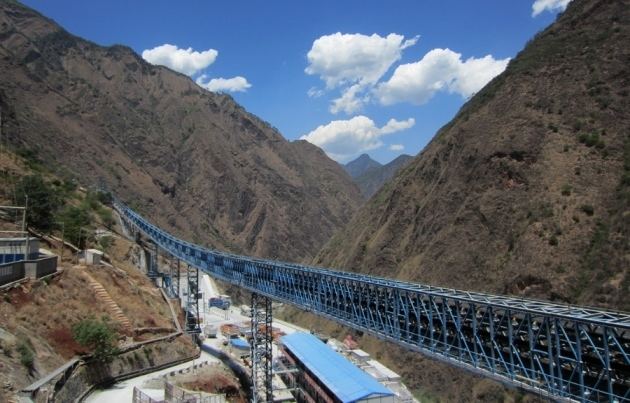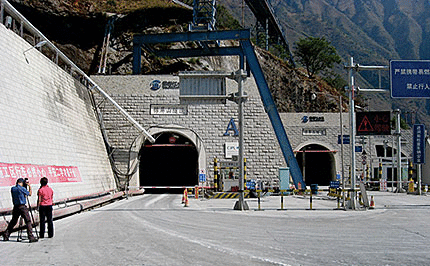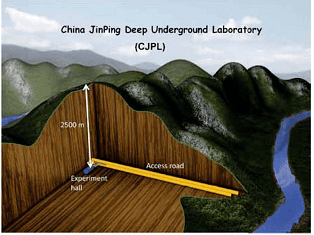Opened 12 December 2010 Function Laboratory | Director Cheng Jianping | |
 | ||
Established December 12, 2010 (2010-12-12) Faculty Zeng ZhiMa HaoLi JianmingWu Qifan Owner Yalong River Hydropower Development Company Similar Ertan Dam, Sudbury Neutrino Observatory, XMASS, Jinping‑I Dam, Grandview Mall Aquarium | ||
The China Jinping Underground Laboratory (Chinese: 中国锦屏地下实验室; pinyin: Zhōngguó jǐn píng dìxià shíyàn shì) is a deep underground laboratory in Sichuan, China. The cosmic ray rate in the laboratory is under 0.2 muons/m²/day, placing the lab at a depth of 6720 m.w.e. and making it the best-shielded underground laboratory in the world. The actual depth of the laboratory is 2,400 m (7,900 ft), yet there is horizontal access so equipment may be brought in by truck.
Contents

Although the marble through which the tunnels are dug is considered "hard rock", at the great depth it presents greater geotechnical engineering challenges than the even harder igneous rocks in which other deep laboratories are constructed. The 10 MPa (1500 psi; 99 atm) water pressure in the rock is also inconvenient. But marble has the advantage for radiation shielding of being low in radionuclides, such as 40K, 226Ra, 232Th, and 238U. This in turn leads to low levels of radon (222Rn) in the atmosphere.

The laboratory is in western China, near Tibet, about 500 km (310 mi) southeast of Chengdu. The closest major airport is Xichang Qingshan Airport, 120 km (75 mi) away by road.
History

The Jinping-II Dam hydroelectric power project involved excavating a number of large tunnels under Jinping mountain: four large 16.7 km (10.4 mi) headrace tunnels carrying water east, two 17.5 km (10.9 mi) vehicular access tunnels, and one water drainage tunnel. Hearing of the excavation in August 2008, physicists at Tsinghua University determined that it would be an excellent location for a deep underground laboratory, and negotiated with the hydropower company to excavate laboratory space in the middle of the tunnels.

A formal agreement was signed on 8 May 2009, and excavation was promptly started. The first phase CJPL-I, consisting of a 6.5×6.5×42 m (21×21×138 ft) main hall, plus 55 m (180 ft) of access tunnel (4,000 m³ total excavation) was excavated by May 2010, and construction completed 12 June 2010. A formal laboratory inauguration was held 12 December 2010.
The laboratory is to the south of the southernmost of the seven parallel tunnels, traffic tunnel A.
CJPL-II expansion

The laboratory is current undergoing a major (50-fold) expansion. Rock excavation was complete by the end of 2015,:17, the halls are currently being fitted out, and are expected to be ready for occupation in January 2017.:20 This will make it the world's largest underground laboratory, exceeding the current record-holder the Laboratori Nazionali del Gran Sasso.

Slightly west of CJPL-I, two bypass tunnels are left over from constructing the seven tunnels of the hydropower project. They are sloped criss-crossing tunnels which connect the five water tunnels (four headrace and one drainage) to the road tunnels beside and slightly above them. Totalling 210,000 m3 (7.4×10^6 cu ft),:4 they have been donated to the laboratory and will be used for support facilities.:5
The expansion has added 151,000 m3 (5.3×10^6 cu ft),:4 of additional excavation: some interconnecting access tunnels, four large experimental halls, each 14×14×130 m (46×46×427 ft),:6:12:15 and two pits for water shielding tanks 16 m (52 ft) deep below the halls' floors.:20–21 Although greater depth and weaker rock force the halls to be narrower than the 20 m (66 ft) wide main halls of LNGS, their combined length of 520 m (1,710 ft) provides more floor space (7003728000000000000♠7,280 vs. 7003600000000000000♠6,000 m2) than LNGS's three halls totalling 300 metres (980 ft).
CJPL's halls also enclose slightly more volume than whose of LNGS. CJPL has 7004933000000000000♠93,300 m3 in the halls proper, and an additional 7003560000000000000♠5,600 m3 in the shielding pits making a total of 7004989000000000000♠98900 m3, slightly more than LNGS's 7004951000000000000♠95,100 m3.
Including the service areas outside the main halls, the result is about 7005200000000000000♠200,000 m3 of usable space:18, more than LNGS's grand total of 7005180000000000000♠180,000 m3. CJPL's total volume of 7005361000000000000♠361,000 m3 would suggest that CJPL is twice the size, but that would be misleading; all of LNGS's excavation was designed to be a laboratory, and thus can be used more efficiently than CJPL's repurposed tunnels.
Due to the laboratory's location within a major hydroelectric facility, additional electrical power is readily available. CJPL-II is supplied by two redundant 10 kV, 7007100000000000000♠10 MVA power cables;:15:21 available power is temporarily limited by the 5×250 kVA step-down transformers in the laboratory (one per experiment hall, and a fifth for facilities).:15 There is likewise no shortage of water:14 for cooling high-powered equipment.
The muon flux (and thus water equivalent depth) in CJPL-II has not yet been measured, and may differ slightly from CJPL-I, but it will certainly remain lower than SNOLAB in Canada and thus retain the record for the world's deepest laboratory as well.
Experiments
Experiments currently operating in CJPL are:
Also operating in the laboratory is a low background facility using a high purity germanium detector, for measuring very low levels of radioactivity.:7 This is not a physics experiment itself, but tests materials intended for use in the experiments. It also tests materials used to construct CJPL-II.:27–32
Experiments currently planned for CJPL-II are::24–29:23
Proposals also exist for:
